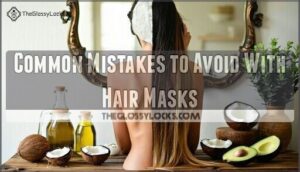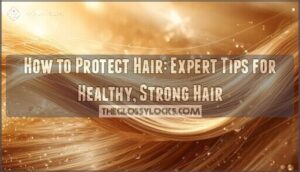This site is supported by our readers. We may earn a commission, at no cost to you, if you purchase through links.

Avocado’s fatty acids provide deep hydration, coconut oil penetrates deeply for lasting moisture, and egg yolk delivers strengthening protein and vitamins. The key is choosing ingredients that match your hair’s porosity and applying them to clean, slightly damp hair for maximum absorption.
Table Of Contents
- Key Takeaways
- Best DIY Hair Masks for Split Ends
- Key Ingredients and Their Hair Benefits
- Step-by-Step Guide to Making Hair Masks
- How to Apply DIY Hair Masks Effectively
- Tips for Preventing and Managing Split Ends
- Essential Oils for Healthier Hair
- Common Mistakes to Avoid With Hair Masks
- Are DIY Hair Masks Safe for All Hair Types?
- Frequently Asked Questions (FAQs)
- What is the best hair mask for Split Ends?
- How to prevent split ends at home?
- How to remove Split Ends from hair?
- What is the best home remedy to prevent split ends?
- How do you make a homemade hair mask?
- How to make a hair mask for damaged dry hair?
- Can a hair mask fix split ends?
- What is the best homemade hair oil for split ends?
- What is the homemade recipe for hair breakage?
- Can hair masks prevent split ends completely?
- Conclusion
Key Takeaways
- You’ll get better results by choosing ingredients that match your hair type – fine hair needs lighter oils like argan, while thick hair benefits from heavier coconut oil treatments.
- Apply masks to clean, slightly damp hair for maximum absorption – shampoo first to remove buildup, then towel-dry gently before applying your DIY treatment from mid-length to ends.
- Consistency matters more than marathon sessions – use masks weekly for 20-30 minutes rather than occasional lengthy treatments to see real improvements in split end appearance.
- Remember that masks can’t permanently fix split ends – they’ll temporarily smooth and seal damaged areas, but you’ll still need regular trims every 6-8 weeks to truly eliminate split ends.
Best DIY Hair Masks for Split Ends
You don’t have to live with frayed, damaged hair ends when your kitchen holds the perfect solutions.
These eight proven DIY hair masks use simple ingredients to temporarily smooth split ends and restore moisture to brittle strands.
Castor Oil Hair Mask
Why settle for expensive salon treatments when castor oil delivers powerful split ends treatment at home?
This DIY hair mask combines castor oil with olive and mustard oils for maximum repair.
Mix equal parts, apply from mid-length to tips, and wrap with a towel for 30 minutes.
The ricinoleic acid strengthens hair cuticles while reducing breakage by 35%.
Use weekly for best results.
Coconut Oil Mask
Coconut oil transforms dry, damaged strands into silky smooth hair. This tropical treasure penetrates deeply, delivering moisture where you need it most. Unlike heavier oils, coconut’s lightweight formula won’t weigh down fine hair.
Here’s your coconut oil mask recipe:
- Mix ingredients: Combine 2 tablespoons coconut oil with 1 tablespoon olive oil
- Apply thoroughly: Work mixture from mid-length to ends, focusing on split ends
- Cover and wait: Use a shower cap, leave for 20-30 minutes
- Rinse completely: Use cool water first, then shampoo normally
The antimicrobial benefits help fight scalp irritation while sealing split ends temporarily. Apply this diy hair mask weekly for best results. Coconut oil’s natural proteins strengthen damaged cuticles, making this split ends treatment perfect for overnight masks when you need intensive repair.
Avocado Mask
Creamy avocado transforms brittle split ends into silky strands.
Nature’s protein powerhouse transforms damaged strands into salon-worthy smoothness
You’ll mash one ripe avocado with two tablespoons each of olive oil and coconut oil for this nourishing diy hair mask.
Apply this avocado hair mask from mid-length to ends, focusing on damaged areas.
Cover with a shower cap and wait thirty minutes.
The avocado benefits include deep moisture and fatty acids that temporarily seal split ends.
Rinse thoroughly, then shampoo, and use this hair repair treatment twice weekly for best results.
Egg Yolk Mask
Egg yolk delivers potent yolk nutrients including protein, biotin, and vitamins A and E that strengthen damaged hair shafts.
Apply the whisked yolk from mid-lengths to ends, avoiding scalp application to prevent greasiness.
Leave your diy hair mask for split ends on 15-30 minutes, then use a cold rinse to prevent coagulation.
This homemade hair mask works best with weekly mask frequency for ideal split ends repair.
Banana and Yogurt Mask
This powerhouse diy hair mask combines ripe bananas with plain yogurt for damaged hair repair.
Mash one banana with two tablespoons yogurt, then apply this homemade hair mask from roots to tips.
Leave for thirty minutes before rinsing.
The banana varieties provide potassium and vitamins while yogurt benefits include protein for strengthening.
Use twice weekly for expected results against split ends.
Milk and Honey Mask
This nourishing milk and honey mask combines powerful keratin benefits with gentle milk proteins to strengthen damaged hair.
Honey properties encourage scalp regeneration while milk softens your strands naturally.
For this homemade hair mask, mist one cup of milk mixed with one tablespoon of honey onto clean hair. This honey hair mask works as an effective diy hair mask for split ends through proper mask application techniques, utilizing the natural properties of milk.
Banana and Olive Oil Mask
This powerhouse combination transforms dry, damaged strands into silky smoothness. Banana’s potassium strengthens hair while olive oil seals moisture deep into each strand.
Quick Steps:
- Blend one ripe banana with one tablespoon olive oil until smooth
- Apply mixture in shower, focusing on split ends
- Leave for 10-15 minutes before rinsing thoroughly
Choose overripe bananas for easier blending and maximum nutrients. Extra virgin olive oil works best for this diy hair mask. Apply at room temperature for comfortable application.
Bananas contain silica and zinc, which are great for combating frizz. Expect smoother, shinier hair after just one use of this banana hair mask.
Avocado and Olive Oil Mask
Rich avocado benefits shine when you blend half an avocado with half a cup of olive oil.
This DIY hair mask delivers deep moisture to damaged strands while olive oil properties add sleekness and shine.
Apply the mixture only to split ends, avoiding roots.
Leave on for thirty minutes before rinsing.
This split end repair treatment temporarily makes damaged hair look healthier through targeted hair repair, providing a solution that offers sleekness and shine.
Key Ingredients and Their Hair Benefits
Understanding the right ingredients makes all the difference when creating effective DIY hair masks for split ends.
Each natural component brings specific benefits that target different aspects of hair damage and repair, and complete concepts of these ingredients are crucial for the best results.
Avocado for Deep Hydration
Avocado benefits go beyond nutrition—this creamy fruit transforms dry, damaged strands into silky perfection.
Packed with moisture-rich fatty acids and antioxidants, avocado penetrates your hair’s cuticle to boost hydration levels dramatically.
Hair porosity determines how well your strands absorb this nourishing treatment.
For split ends, mash half an avocado with coconut oil twice weekly for ideal hair repair mask results.
Banana for Strength and Repair
You can think of banana as nature’s repair shop for damaged hair.
The banana nutrients including vitamin C and potassium work together to strengthen weak strands and boost your scalp benefits. This homemade hair mask ingredient transforms brittle hair into healthier locks.
- Potassium power: Repairs split ends while strengthening your hair repair mask formula
- Vitamin boost: Creates an effective hair strengthening mask that targets damage at the root
- Yogurt pairing magic: Combines with yogurt and rosewater effects for enhanced mask frequency results
Olive Oil for Shine and Moisture
Versatility makes olive oil a powerhouse ingredient for split ends and hair repair mask solutions.
This liquid gold penetrates your hair shaft deeply, delivering vitamins A and E for lasting moisture and brilliant shine.
You’ll notice smoother strands after each homemade hair mask application.
The olive oil benefits extend beyond surface conditioning—it strengthens damaged cuticles while promoting scalp health through gentle nourishment and protection, making it a great tool for hair repair.
Egg Yolk for Protein Boost
Egg yolks pack a powerful protein punch for damaged hair, delivering vitamins A, E, biotin, and folate directly to your roots.
Nature’s protein powerhouse delivers vitamins A, E, biotin, and folate straight to your roots
This scalp nutrient infusion strengthens weak strands while promoting healthy growth.
Your homemade hair mask becomes a protein powerhouse when you add egg yolk, making it perfect for split ends treatment.
Apply this DIY hair mask to clean, dry hair and rinse with cold water to prevent curdling.
Coconut Oil for Softness
From roots to tips, coconut oil works wonders for thick, dry hair that needs serious softening.
The oil’s unique ability to penetrate hair shafts makes it perfect for overnight treatment sessions.
Apply a teaspoon for fine hair or tablespoon for thicker strands, focusing on scalp application for maximum coconut benefits.
This homemade hair mask ingredient transforms brittle split ends into manageable locks through superior oil absorption properties.
Honey for Regeneration
Honey acts as nature’s repair kit for damaged hair strands. This golden ingredient contains vitamins B6 and C that boost keratin production, while its anti-inflammatory properties soothe irritated scalps.
Nature’s golden treasure delivers instant keratin boost and scalp healing power
Studies show honey application improves hair flexibility by 17% and reduces split ends by 28%.
Key honey benefits for your homemade hair mask:
- Moisture magnet – Draws humidity from air to hydrate dry strands
- Scalp regeneration – Antimicrobial action reduces dandruff in 62% of cases
- Protein repair – Enzymes rebuild weakened hair structure naturally
Mix honey with carrier oils like coconut or olive oil for easier application. Use a 1:2 ratio of honey to other ingredients in your DIY hair masks for ideal results.
Lemon Juice for Cleansing
Lemon juice acts as nature’s clarifying agent for your scalp and hair.
This citrus powerhouse restores lemon pH balance while providing gentle scalp exfoliation that removes buildup and dead skin cells.
You’ll notice improved dandruff control and significant oil reduction after regular use.
The natural acids in lemon enhance shine enhancement while helping repair hair damage.
When combined in homemade hair mask recipes, especially lemon and egg DIY hair masks, it creates a powerful treatment that addresses split ends while keeping your scalp healthy and refreshed.
The combination of lemon and other ingredients provides a powerful treatment for hair care.
Step-by-Step Guide to Making Hair Masks
Creating effective DIY hair masks starts with selecting ingredients that match your hair’s specific needs and damage level.
You’ll want to measure ingredients carefully and mix them thoroughly to guarantee even distribution and maximum benefits for your split ends.
This process is crucial as it ensures that your hair receives the necessary treatment to address its specific needs.
Choosing The Right Ingredients
Now that you understand what each ingredient brings to your homemade hair masks, selecting the right ones becomes straightforward.
Your hair’s unique needs should guide your choices, not trending ingredients that mightn’t work for you.
Consider these key factors when choosing ingredients for split ends:
- Hair Porosity – Low porosity hair needs lighter oils like argan, while high porosity benefits from heavier coconut oil
- Ingredient Allergies – Always patch test new natural ingredients, especially nuts and eggs
- Mask Consistency – Balance wet and dry ingredients to avoid runny or overly thick mixtures
- Ingredient Freshness – Use ripe avocados and fresh eggs within days of purchase for maximum benefits
- Ethical Sourcing – Choose sustainably harvested oils and organic ingredients when possible for better quality DIY hair treatments
DIY masks often provide tailored hair solutions for specific issues.
Measuring and Mixing Proportions
Getting your ingredient ratios right makes the difference between a game-changing treatment and a goopy mess.
Start with these proven measurements for split ends relief:
| Mask Type | Primary Ingredient | Secondary Ingredients |
|---|---|---|
| Avocado Base | 1 ripe avocado | 2 tbsp olive oil + 2 tbsp coconut oil |
| Egg Protein | 1 egg yolk | 1 tbsp honey + 2-3 tbsp olive oil |
| Banana Repair | 1 ripe banana | 2 tbsp yogurt + few drops lemon juice |
Measurement accuracy prevents waste and guarantees proper mask consistency for homemade hair masks.
You can find various mask components to customize your recipes.
Tips for Quick and Easy Preparation
Making homemade hair masks doesn’t require fancy equipment or complicated steps. With proper ingredient prep and simple recipes, you’ll master efficient blending techniques that save time and reduce mess.
Here are three hair mask preparation tips for minimal cleanup:
- Gather everything first – Line up all hair mask ingredients, bowls, and mixing tools before you start
- Use disposable containers – Paper bowls or plastic cups make storage solutions easier and eliminate washing dishes
- Pre-measure portions – Cut avocados, crack eggs, and measure oils beforehand to streamline the mixing process
These hair mask tips help you tackle split ends without turning your kitchen into a disaster zone.
How to Apply DIY Hair Masks Effectively
You’ll get better results from your DIY hair masks when you apply them correctly to clean, slightly damp hair.
The right technique guarantees even coverage and maximum absorption, so your split ends get the nourishment they need to appear healthier.
Preparing Hair for Mask Application
Proper preparation sets the stage for successful hair mask application. Start by shampooing beforehand with warm water to open your hair cuticles, allowing deeper ingredient penetration.
Gently towel dry your damp hair to remove excess moisture without causing breakage. Next, detangle hair using a wide-tooth comb to prevent further damage.
Consider sectioning hair into manageable parts for even coverage. Light scalp stimulation during preparation boosts circulation, enhancing the mask’s effectiveness against split ends.
This process helps ensure that the hair mask is applied under optimal conditions, with proper preparation being key to its success.
Application Techniques for Even Coverage
Once your hair’s prepped, focus on achieving mask saturation through strategic application. Sectioning hair into four parts guarantees every strand gets covered. Start with root application, then work toward damaged ends for consistent coating.
- Sectioning Hair: Divide into quadrants using clips for thorough DIY hair masks coverage
- Comb Usage: Wide-tooth combs distribute thick masks evenly without causing breakage
- Finger Smoothing: Use palms to rake product from roots to tips, feeling for dry spots
- Layering Technique: Apply thin layers multiple times for better hair mask benefits absorption
- Massage Method: Gentle circular motions improve penetration and blood flow to follicles
Consider using natural oils for added moisture and shine during the application process.
Tools for Application
You’ll need the right tools to apply your hair mask evenly.
Wide-tooth combs work best for distributing thick masks without breaking wet hair.
Applicator bottles help control runny mixtures like coconut oil treatments.
Use mixing bowls to blend ingredients thoroughly.
A quality comb selection guarantees even product distribution.
Always wear gloves when handling messy DIY hair masks to protect your hands from staining or irritation, and use the right tools for a quality application, ensuring even product distribution.
How Long to Leave Masks On
Timing matters when you’re dealing with split ends and homemade hair masks.
Most masks need 20-30 minutes for proper mask absorption, but overnight masks work better for severely damaged hair.
Egg-based treatments require shorter durations to prevent protein overload.
Always rinse thoroughly after the ideal duration.
Remember, frequency matters more than marathon sessions – consistent weekly treatments beat occasional lengthy applications for effective hair damage prevention.
Rinsing and Aftercare Tips
Rinse your hair mask with cool water to seal cuticles and lock in nutrients.
Use gentle towel-drying motions instead of aggressive rubbing to prevent breakage.
Follow with leave-in conditioners or serum application for extra protection.
Consider protective styling afterward to maintain your mask’s benefits and prevent further split ends damage.
Tips for Preventing and Managing Split Ends
While hair masks can temporarily improve split ends’ appearance, prevention is your best strategy for healthy hair.
You’ll need to combine regular trims with protective habits and proper moisturizing to keep split ends from forming in the first place.
Regular Trimming Advice
While effective hair masks can improve your hair’s appearance temporarily, you can’t truly fix split ends without cutting them off.
Professional trims every 6-8 weeks prevent damage from traveling up the hair shaft, keeping your locks healthier longer.
Essential trimming frequency guidelines:
- Schedule professional trims every 6-8 weeks for damaged hair, every 10-12 weeks for healthy hair
- Invest in sharp haircutting shears if self-trimming – dull scissors create more splits
- Trim 1/4 to 1/2 inch above visible damage to guarantee complete removal
Reducing Heat and Chemical Damage
Without proper precautions, your styling routine becomes split ends’ best friend.
Heat Protectants create a barrier against damage, while Chemical-Free Products prevent brittleness that leads to hair breakage.
Choose Gentle Styling methods over aggressive tools—your damaged hair will thank you.
Prioritizing Hydration Importance through natural hair mask treatments supports Damage Reversal.
Skip the harsh chemicals and embrace homemade hair masks for healthier strands.
Importance of Moisturizing and Oiling
Regular moisturizing creates your first defense against split ends.
Well-hydrated hair maintains its elasticity and resists breaking at vulnerable ends.
- Hydration benefits: Moisture keeps hair flexible and prevents brittleness that leads to splitting
- Oil penetration: Coconut oil and olive oil deeply nourish hair shafts for lasting protection
- Scalp health: Regular oiling promotes healthy growth from roots to tips
- Damage prevention: Consistent moisturizing shields hair from environmental stressors
- Shine enhancement: Properly hydrated hair reflects light naturally for gorgeous results
Protective Hairstyles and Habits
Beyond regular moisturizing and oiling, your hairstyling choices can make or break your split end prevention efforts.
Smart protective habits shield hair from daily damage while you sleep and style.
| Protective Method | Best Practice | Why It Works |
|---|---|---|
| Nighttime Protection | Use silk scarves or pillowcases | Reduces friction and moisture loss |
| Gentle Detangling | Wide-tooth combs on damp hair | Prevents breakage and stress |
| Avoiding Tightness | Loose braids instead of tight ponytails | Minimizes tension on hair shafts |
These simple changes complement your DIY hair masks and homemade remedies perfectly.
Many find that flat twists benefit hair health.
Essential Oils for Healthier Hair
Essential oils can transform your hair care routine by targeting specific scalp and hair concerns that contribute to split ends.
When used properly with carrier oils, these concentrated plant extracts provide powerful nutrients that strengthen hair from root to tip, and offer a solution to common hair problems through complete concepts.
Tea Tree Oil for Scalp Health
Tea tree oil acts as your scalp’s personal bodyguard against common hair problems.
This powerhouse essential oil delivers potent antifungal and antiseptic properties that tackle dandruff control and scalp inflammation head-on.
Here’s how tea tree benefits transform your hair care routine:
- Dandruff control – Fights fungal infections causing flaky scalp
- Hair growth – Unclogs pores for healthier follicles
- Oil dilution – Mix with coconut oil for gentle scalp treatment
Always dilute tea tree oil before applying to prevent irritation.
Many users buy tea tree oil products for ease of use.
Argan Oil for Shine and Strength
Unlike expensive salon treatments, argan oil delivers premium results at home.
This liquid gold strengthens damaged hair while boosting natural shine.
Rich in vitamin E and fatty acids, argan oil masks penetrate deeply to repair split ends.
You’ll see smoother, healthier hair after just one treatment.
Mix with coconut oil for enhanced benefits, or apply pure argan oil directly to damp ends for a liquid gold treatment that leaves hair with a natural shine.
How to Safely Use Essential Oils
While many essential oils offer impressive benefits, using them incorrectly can damage your hair ends rather than help them heal.
Safe application starts with proper dilution ratios and careful attention to your skin’s response.
Here’s how to protect yourself while maximizing results:
- Always dilute essential oils – Use 1-2 drops per tablespoon of carrier oils like coconut or jojoba
- Perform patch testing 24 hours before applying any new oil blend to your scalp
- Follow safe dosages – Never exceed 2-3% concentration for hair treatments
- Watch for photosensitivity risks – Some oils increase sun sensitivity, so apply evening treatments
- Start slowly – Begin with once-weekly applications to gauge your hair’s reaction
Remember that essential oils in DIY hair masks work best when you respect their potency and your hair’s unique needs.
Common Mistakes to Avoid With Hair Masks
Even the best DIY hair masks can backfire if you make common application mistakes.
You’ll want to avoid these four pitfalls that can damage your hair or waste your time with ineffective treatments.
Using Hot Water With Egg Masks
Hot water turns your egg hair mask into scrambled breakfast instead of a nourishing hair treatment.
Keep eggs cool or your hair mask becomes breakfast instead of beauty treatment
Protein denaturing occurs when heat hits egg proteins, creating clumps that stick to damaged hair strands.
This ruins mask effectiveness and can cause scalp burns. Always rinse egg-based hair treatment recipes with cool water to maintain hair mask safety and preserve hair strength benefits.
Overusing Protein-Based Masks
Too much protein can backfire on your hair.
When you overuse protein-heavy masks like egg treatments, you risk protein overload, making strands stiff and brittle.
This mask addiction creates hair weakness instead of strength.
Balance is key – alternate protein treatments with moisturizing DIY hair masks to prevent hair damage and maintain healthy split ends repair.
Applying Masks on Dirty Hair
Against conventional wisdom, applying a DIY hair mask to dirty hair actually undermines your efforts.
Product buildup, oils, and pollutants create barriers that prevent ingredients from penetrating your hair shaft effectively. Your mask timing becomes pointless when dirt blocks nourishment.
Always shampoo first with warm water to open cuticles, then towel-dry gently before application.
Clean hair preparation guarantees maximum absorption and split ends repair, ensuring that your hair mask works as intended to provide effective nourishment.
Ignoring Hair Type Differences
Your DIY hair mask success depends on matching ingredients to your specific hair type.
Fine hair can become weighed down by heavy oils, while thick hair needs richer formulations for effective split ends treatment.
- Hair Texture matters: Fine strands need lighter coconut oil masks, while coarse hair benefits from heavier avocado treatments
- Porosity Matters for absorption: High-porosity hair drinks up protein masks quickly, but low-porosity hair requires heat for penetration
- Curl Patterns and scalp conditions determine frequency: Fragile strands with tight curls need gentler, less frequent applications than straight hair
Are DIY Hair Masks Safe for All Hair Types?
While DIY hair masks work for most people, you’ll want to adjust recipes based on your specific hair type and needs.
Oily or fine hair requires lighter formulations, and those with severe damage or scalp conditions should consult a professional stylist first.
Customizing Masks for Oily or Fine Hair
When customizing DIY hair masks for specific hair textures, you’ll need different approaches for oily versus fine hair.
Fine hair requires lighter ingredients to prevent weighing it down, while oily hair benefits from clarifying components.
| Hair Type | Best Ingredients | Application Tips |
|---|---|---|
| Oily Hair | Lemon juice, clay, tea tree oil | Focus on scalp, rinse thoroughly |
| Fine Hair | Light oils (argan), egg whites | Apply mid-length to ends only |
| Both Types | Honey, yogurt | Use smaller amounts, shorter timing |
Fine hair tips include using half the recommended oil amount and limiting application time to 15-20 minutes.
For oily hair care, incorporate clarifying ingredients like lemon juice to balance excess sebum production without over-drying.
When to Seek Professional Advice
Sometimes hair care requires professional intervention beyond DIY solutions.
Persistent Hair Damage, severe chemical burns, or scalp conditions need Expert Guidance from trained hair professionals. DIY hair masks can’t fix every problem.
Consider Professional Help when you experience:
- Severe breakage – Hair snaps constantly despite regular hair treatment and moisturizing routines
- Scalp irritation – Persistent itching, burning, or redness that doesn’t improve with gentle hair care
- Chemical damage – Extreme dryness or texture changes after salon treatments requiring specialized Split End Repair techniques
Hair professionals provide targeted Salon Advice for complex issues.
Frequently Asked Questions (FAQs)
What is the best hair mask for Split Ends?
Picture Sarah watching her damaged hair literally split before her eyes during her morning routine.
You’ll find avocado and olive oil masks work best for split ends. The avocado provides deep moisture while olive oil seals cuticles, temporarily improving appearance until your next trim, using olive oil.
How to prevent split ends at home?
Trim your hair every six to eight weeks, avoid heat styling, and use a wide-tooth comb. Don’t skip conditioner, and apply nourishing oils weekly.
Protect your hair from harsh weather, and keep chemical treatments to a minimum, which involves avoid heat styling.
How to remove Split Ends from hair?
Split ends can’t be permanently repaired—only trimmed away.
You’ll need regular cuts every 6-8 weeks to remove damaged ends completely.
Hair masks temporarily smooth split ends but won’t heal them.
What is the best home remedy to prevent split ends?
Regular oiling with coconut or olive oil creates a protective barrier that prevents moisture loss.
You’ll also want to limit heat styling, use gentle hair ties, and get regular trims every 6-8 weeks to maintain healthy ends.
How do you make a homemade hair mask?
Blend ripe avocado with olive oil and coconut oil, then apply this nourishing mixture to damp hair.
You’ll create an effective treatment that moisturizes damaged strands and temporarily improves split ends’ appearance.
How to make a hair mask for damaged dry hair?
Revive your incredibly parched, lifeless strands with a nourishing blend of one mashed avocado, two tablespoons olive oil, and coconut oil. Apply this moisture-packed treatment for thirty minutes before shampooing.
Can a hair mask fix split ends?
Hair masks can’t permanently fix split ends, but they’ll temporarily smooth and seal damaged areas.
You’ll need regular trims to truly eliminate split ends since they can’t repair once the hair structure breaks.
What is the best homemade hair oil for split ends?
Coconut oil combined with olive oil creates the most effective homemade treatment for split ends.
You’ll mix equal parts of both oils, apply to damaged areas, and leave for thirty minutes before washing with cool water and shampooing.
What is the homemade recipe for hair breakage?
Like a lifeline for fraying strands, you’ll need one egg yolk, two tablespoons honey, and three tablespoons olive oil. Mix these ingredients, apply to damp hair, and leave for thirty minutes before washing out.
Can hair masks prevent split ends completely?
Unfortunately, you can’t prevent split ends completely with hair masks. Once your hair structure breaks and frays, it continues splitting like an unraveling thread.
Hair masks only temporarily mask the appearance while regular trims remain necessary.
Conclusion
While store-bought treatments promise miraculous results, your kitchen holds the real power to transform damaged hair naturally. DIY hair masks for split ends offer an affordable, chemical-free solution that actually works.
You’ve learned eight proven recipes using ingredients like avocado, coconut oil, and egg yolk. Remember to match ingredients to your hair’s needs and apply consistently for best results.
With regular use and proper application techniques, you’ll notice smoother, healthier hair that resists future damage, achieving healthier hair that is the ultimate goal of these natural treatments.
- https://www.onlymyhealth.com/want-to-get-rid-of-split-ends-here-are-6-natural-diy-hair-masks-to-treat-them-1610454356
- https://draxe.com/beauty/diy-hair-mask-for-damaged-hair/
- https://valentia.com/blogs/discovering-skincare/diy-hair-mask-for-split-ends-a-step-by-step-guide
- https://www.luxyhair.com/blogs/hair-blog/7-diy-hair-masks-we-know-youll-love
- https://www.healthline.com/health/avocado-hair-mask










